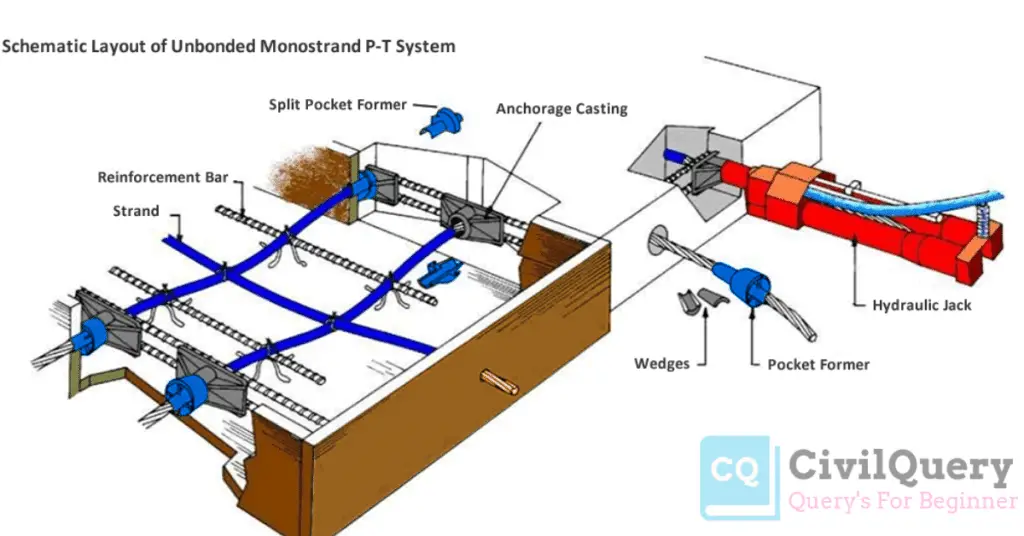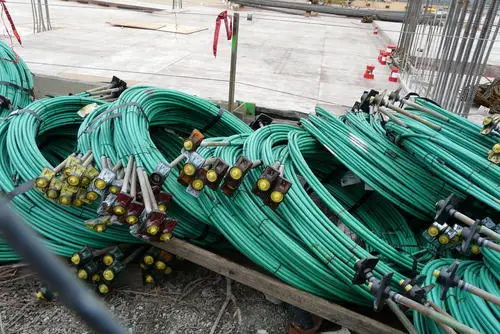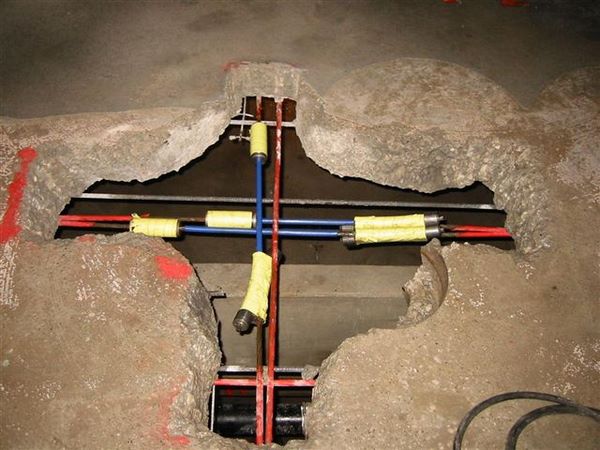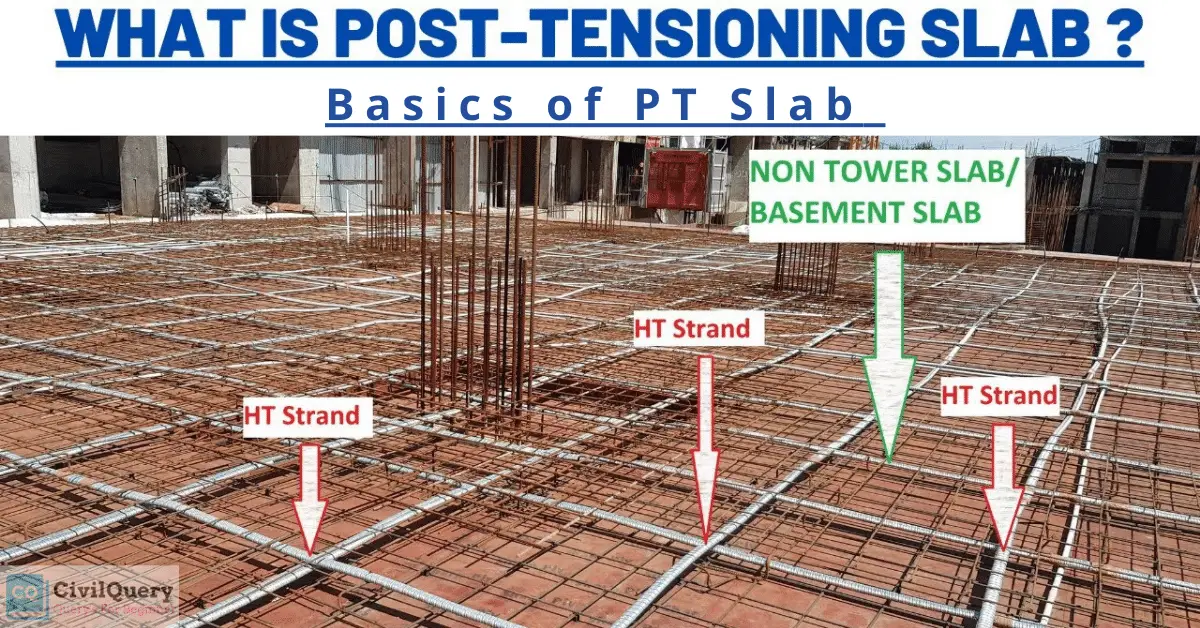Post tension slab is an advanced version of conventional slab reinforcement which is used with the help of high-strength steel tendons, which provide tension after the concrete has pasted there. It is not like an ordinary Reinforced Cement Concrete slab.
This has been popular for the last 30 years, which is really used in different building structures such as Dams, Commercial buildings as well as silos, pavements, etc. Sydney Opera House, 1973 is one of the famous building structures which was made by this advanced slab.
Contents
What is a post-tensioning slab??

This is a technique to provide reinforcing concrete with advanced level as we discussed above. This technique helps in the formation of the thinner slab and tend to longer time with column-free space.
It uses high-strength steel which led to compresses the slabs and provides tension in the slab. This is a method of utilizing less material and cost-efficiently. It is an effective method as compared to RCC (Reinforced cement concrete ) method.
It makes a better and attractive building structure. This is really useful and providing maximum output in the present world of the building structure.
It consists of several parts ducts(these are connected with each other to make powerful holding by an external screw coupling and sealed with PE tape.
Tendons( It is a primary element of a post-tensioning system which is made up of steel with a protective coating), and Anchors(It is used to connect or join two tendons, it transfers the stressing force to the concrete once the stressing process is completed).
Post tension slab foundation
Foundation is a key resource of any building. All structure depends on the foundation. So, to make a strong base foundation, PT slab used reinforced concrete structure with stranded steel cables which provide tension to it.
It leads to the concrete hardens. The plastic sheathing is used to prevent stranded steel tendons from concrete. After foundations strong hardened, it leads to plastic-sheathing and stretched the post-tensioned cables which led a force to the concrete system and lift the slab (compressed state)
Post-tension slab drilling
After the concrete foundation, PT slabs look that other concrete placed on the ground. This is really strong and hard but due to drill, it can affect its tension. It can cause sudden energy which affects the slab and anyone. Potentially, If someone wants to drill at slab, keep in mind that the below slab is a tension if it will cut, difficult to repair. Make sure the drill has to do properly and carefully.
Post tension slab repair

Sometimes, it has seen that the PT slab is not maintained very well due to some problems. PT slab needs repair is required to escape from danger, injury, and a big loss.
When the slab faced problems like Concrete spalling, Delaminated concrete, Cracking patterns, Efflorescence, Rust staining, Excessive deflection, Tendon eruption from the structure, Some previous repair evidence or structure modification.
That time required to contact some experience contractor demand for these services such as Tendon splicing, Strand replacement, Concrete repair, Epoxy and urethane injection, Grouting and sealing cracks, Joint sealants, Expansion joint repair, Void grouting according to the problem.
Post tension slab crack repair
In the PT slab, it was seen that cracks coming because of Over tensioning, lack of proper structural design, lack of proper load estimation and temperature, conditions. Bad stressing of wires to lockout properly.
Overloading can also cause cracks in the slab. Microcracks are also caused because of bad water curing. Then, pouring of cold water we didn’t get to microcracks due to sun reflection and it can be reduced by hot water.
Mostly, points covered can lead to crack. All points should be in mind at the time of establishing the PT slab and overcome all of it. If we faced after problem we have to contact a contractor to demand above point services such as Concrete repair, Void grouting, sealing cracks, joint sealants according to demand.
Post tension slab vs Pier and beam
Pier and beam is a foundation in which piers are placed deep within the soil which was seen in the traditional house also. Beams are laying across the house to provide stabilize and carry the weight of the house. In the foundation, there is a crawl space that provides facilities electrical wires, plumb, etc. That is more expensive in the number of times, labor, and cost.
While in the PT slab foundation, consists of a concrete slab with steel-stranded tension which provides a strong foundation. Fast to build, save time, and less expensive but the problem of crack and repairs.
Post-tensioning of concrete
Concrete is one of the most important keys to a construct slab. This is the primary and significant material in which the tendons are tensioned to provide strength and hardened by force and this force and lastly primary transfer to the concrete through the end anchorages.
There are several usages of PT concrete slabs in residential households, walls, bridges, elevated slabs like parking structures, commercial buildings, and columns, etc. Without concrete, cannot establish a structure.
Post-tension cables

The cables used in concrete construction increase the strength of thin and long slabs. It facilitates more span length between support columns. It involves reinforcing concrete using high-strength steel strands.
These strands are basically called tendons. Designers or contractors need to locate post-tension cables when repairing structures. Basically, it is made up of steel wire with a plastic covering, it is used after pouring concrete. these works can be seen in the construction of Apartment buildings, Office buildings, Slabs-on-ground, Water tanks, Bridges.
Post-tension cable repair

This is a really challenge for PT tension cable repair, as it requires a high level of knowledge and skills to repair the cable of PT. It is one of the expensive methods. After pouring concrete, the cables cannot be de-tensioned.
Some cases like a cable snapped 2-3 inches out of the foundation. At the time, need a proper expert who can identify the cable locations before repairing work. Check out its loose end and with the high pressure, it should be fixed in right place.
A big hazard comes into exists when workers cut into the slab and rupture the tensioned cable which causes loss of life and property
Post tension tendon
In this PT tensioning tendon, It is prestressing strong steel wires or strands, coated with the help of plastic ducts that give super-strength to tensions.
It requires skilled workers to do prestressing before the concrete placed.
After 20- 25 days, when the setting of concrete enough then these tendons are required to stress with the help of stressing jack. Tensioning leads to steel elongation and compression of concrete
Post-tension foundation repair
Foundation is the foremost aspect of all buildings. In PT slab, this is also a big challenge to repair a foundation. If some part of the foundation needs repair, it can possible but when the structure faced different problems such as deteriorated concrete on the east wall, badly rusted rebars, cables, and components, The east side of the home had a noticeable settlement, Horizontal wall movement of the east wall moving away from the rest of the house.
The solution of these foundations is:- Firstly, shore up the structure both vertically and horizontally. Then check out the cables in the affected area. Remove all deteriorated concrete oxidized steel components and inserted new and strong concrete one in place of it.
Then, install new cables with coated items to protect steel components. Underpinning helps in the problem of downward settlement( occur during operation)

